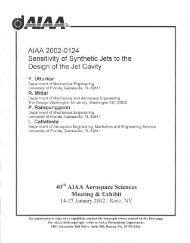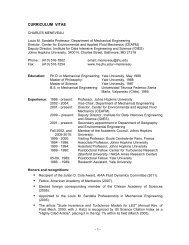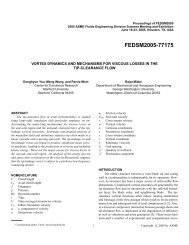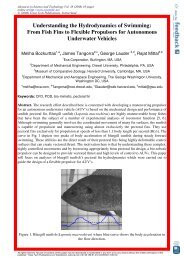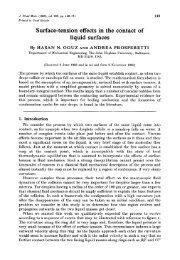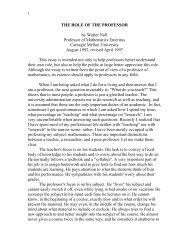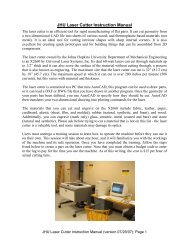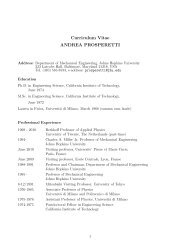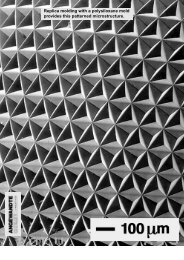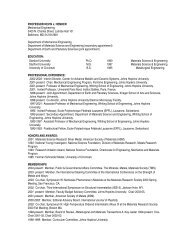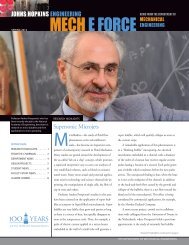A Sharp Interface Cartesian Grid Method for Simulating Flows with ...
A Sharp Interface Cartesian Grid Method for Simulating Flows with ...
A Sharp Interface Cartesian Grid Method for Simulating Flows with ...
Create successful ePaper yourself
Turn your PDF publications into a flip-book with our unique Google optimized e-Paper software.
SHARP INTERFACE CARTESIAN GRID METHOD 361<br />
In this summation, M goes over the surrounding coarse nodes (see Fig. 4d1) and λ denotes<br />
weights corresponding to distance-weighted interpolation as shown in Fig. 4d4.<br />
The above procedure applies in the case where there are no immersed boundaries or to<br />
cells that are distant from the immersed boundary. Now consider a boundary defining an<br />
immersed solid object on the finest level mesh (i.e., one where the solution is sought) and<br />
subsequent coarsening of the mesh <strong>with</strong> the boundary shape retained, as shown in Figs. 4a<br />
and 4b. Some situations, which may arise upon coarsening the mesh in the presence of an<br />
immersed boundary, are indicated in Figs. 4c1 to 4c4. As shown, the fine cells comprising<br />
the coarse cell may lie in solid or fluid phase depending on the manner in which the<br />
sharp interface passes through the fine mesh. In defining the Laplacian operator and also in<br />
affecting transfer between successive mesh levels, care has to be exercised in cells cut by the<br />
immersed boundary. At the finest level, the operators are assembled as detailed in Section 2.3<br />
above. At this level, full in<strong>for</strong>mation on the sharp immersed boundary is retained as in<br />
Figs. 4c1 to 4c4. In the restriction step, residuals from the fine mesh are to be interpolated<br />
to the coarse mesh. At the coarser levels, to avoid coarsening of the embedded geometry,<br />
the geometry is represented using a volume fraction field. In the following discussion, the<br />
implementation procedure is described <strong>with</strong> primary focus on cells that are close to the<br />
immersed boundary.<br />
Any given coarse mesh cell at level k, such as the one shown in Fig. 4b, consists of four<br />
finer cells of level k − 1. Assuming that, based on a set of rules [58], it has already been<br />
determined if a given cell at level k − 1 is in the fluid or in the solid, a procedure needs to<br />
be developed in order to make this determination <strong>for</strong> cells at the current level k. For each<br />
cell at every grid level, a boolean variable β, which has a value of one if the cell is a fluid<br />
cell, and zero if the cell is a solid cell, is defined. Furthermore, a weighting factor ω is also<br />
defined <strong>for</strong> each contributing fine-mesh cell, which corresponds to the fractional volume<br />
contributed by that fine cell to the coarse cell. For a uni<strong>for</strong>m mesh, ω = 1/4 <strong>for</strong> any fine<br />
mesh cell. Given these definitions, the volume fraction of fluid in a coarse cell at level k is<br />
estimated as (Figs. 4d1 to 4d4)<br />
k =<br />
4∑<br />
M=1<br />
ω k−1<br />
M βk−1 M , (24)<br />
where the summation runs over the four fine mesh points surrounding the coarse mesh point.<br />
There<strong>for</strong>e, <strong>for</strong> a coarse cell comprising of all four contributing finer level cells in the fluid<br />
phase, the volume fraction k = 1.0; otherwise 0 ≤ k < 1.0. The Boolean variable β can<br />
now be defined at level k based on the volume fraction of that cell as follows:<br />
β k ij =1 if0.5 < k ij ≤1.0<br />
β k ij =0<br />
if0.0 < k ij ≤0.5.<br />
(25)<br />
The above definition holds <strong>for</strong> all levels k > 1. For the finest level (k = 1) β and <br />
are determined simply based on whether the cell center lies in the fluid or solid region as<br />
follows:<br />
β 1 ij = 1 ij =0<br />
β 1 ij = 1 ij =1<br />
if cell center lies in solid<br />
if cell center lies in fluid.<br />
(26)



